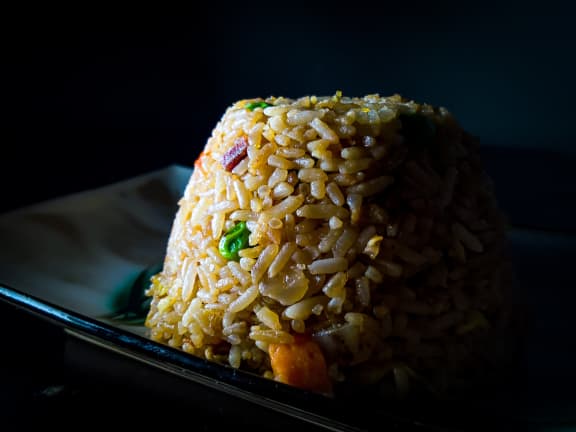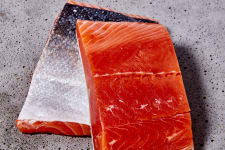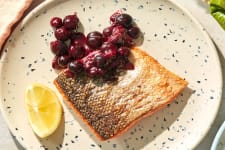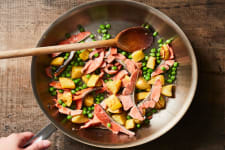
Quick and Easy Salmon Fried Rice
January 14th, 2021How to Repurpose Your Sockeye or Coho
Want to be a leftover legend in your home kitchen? Repurpose last night’s salmon for a healthy, quick, and easy meal of salmon fried rice.
There are so many delicious ways to use up leftover salmon in the kitchen, but salmon fried rice is truly one of our favorite next-day meals. Filling and fragrant, salmon fried rice can be made with basic ingredients that you likely have stashed in your pantry and fridge. That makes it a low-maintenance dish that’s ideal for putting leftover fish and rice to use.
Here’s a quick and easy salmon and rice recipe that makes a basic but flavorful fish fried rice that you can customize to your liking. You can use anything from grilled sockeye to poached coho in your salmon and rice recipe.
Notes:
The right cooking oil for stir fried dishes can withstand high heat without burning. Something like peanut or canola oil works well for stir fries.
Ginger is always a nice addition to stir fries, imparting a fresh, herbaceous flavor that helps to balance out the fried deliciousness of the finished dish, while dried chili flakes of any kind add just a bit of heat to whet your appetite.
Garlic adds a savory umami note that helps to add depth to your stir fry, but if it’s not your thing, consider using a handful of finely diced onions or shallots instead; the flavor profile will be more sweet than savory, but you’ll still be adding dimension to the dish.
Leftover rice makes for the best stir fries since the grains lose excess moisture after being stored in the refrigerator. That means you’re going to get maximum flavor absorption with any liquids and juices you’ve added to the wok, whether that be soy sauce, fish sauce, Shaoxing wine, moisture that has sweated out of an ingredient like onions, etc. In addition, drier, leftover rice will get a proper fry, rather than steaming in the pan — it’s the same reason why you pat a fillet of fish dry in order to get a good sear. Break up the rice if it’s clumped together so that you can easily toss it into the wok.
Soy sauce is the ultimate source of umami, and will be the main seasoning of the dish. If you like the tangy, fishy umami of a good fish sauce, you’ll want to add in a few dashes of that to suit your palette.
Alternatively, if you don’t have any leftover salmon on hand, try pan-searing a couple of packs of our Captain’s Cuts in a separate pan for a quick, crispy dose of protein that you can simply layer on top of your bed of fried rice — crispy skin-side up, of course. Essentially, you want to keep your salmon fried rice process as streamlined as possible, and tossing raw salmon into the wok will likely throw off your fried rice game.
Quick and Easy Salmon Fried Rice
By Wild Alaskan Company
There are so many delicious ways to use up leftover salmon in the kitchen, but salmon fried rice is truly one of our favorite next-day meals. Here’s a quick and easy salmon and rice recipe that makes a basic but flavorful fish fried rice that you can customize to your liking. You can use anything from grilled sockeye to poached coho in your salmon and rice recipe.
Prep time
7 minutes
Cook Time
5 minutes
Total time
12 minutes
Yield
4 servings
Ingredients
- 3 tbsp oil (peanut or canola oil work well for stir-fries)
- 1 tsp ginger, grated or minced
- A pinch of dried chili, optional
- 1 tbsp minced garlic
- 4 cups cooked rice, preferably leftovers that have been refrigerated
- 2 eggs, beaten
- 2 tbsp soy sauce
- A few dashes of fish sauce, optional
- 12 ounces salmon, seasoned and cooked
- Tender green herbs, like cilantro, chives, scallions, Thai basil, etc.
Instructions
1. Ideally, you’ll want to use a wok for stir fries, since the design of the wok gives you lots of surface area to work with, allowing each ingredient to get plenty of direct contact with the cooking vessel. If you don’t own a wok, use the widest pan you have available to make your salmon fried rice. Pro tip: Get your mise en place ready when making any stir fry! In other words, have all of your ingredients measured out and ready to go into the wok so that you can keep things moving in the pan.
2. Heat your cooking oil over high heat, until it’s hot enough that it begins to shimmer. Add in your ginger and chili flakes (if using), frying until they start to release their fragrance — about 10 seconds — then add minced garlic, cooking for another 10 seconds or so until it’s no longer raw.
3. Just before the garlic begins to pick up any color, carefully stir your rice into the dish, moving it around the wok so that each grain gets coated in oil. You want the grains to toast a bit, turning a pale golden color; this will give the rice a nutty aroma and an appetizing texture.
4. Once the rice has begun to turn golden, make a well in the middle of your wok or pan. If it looks a little dry, add an extra splash of oil, then scramble in your eggs, allowing them to cook for a minute before gradually incorporating in the rice so that the cooked egg is evenly distributed throughout your stir fry.
5. Next, add in your soy sauce and fish sauce (if using), stirring until absorbed by the rice. If you have time, take a second to carefully taste your dish to see if it’s seasoned enough for your taste; if it’s not, add a splash more of soy or fish sauce, then stir through.
6. Finally, turn off the heat, then gently incorporate the flaked salmon into the wok, along with any tender green herbs. The residual heat of the pan will bring these to temperature; alternatively, arrange small portions of pan-seared salmon on top of your fried rice as you plate it. Serve the dish with your favorite chili sauce, a side of seasonal veggies, and enjoy your salmon rice immediately.
Consuming raw or undercooked meats, poultry, seafood, shellfish, or eggs may increase your risk of food-borne illness, especially if you have a certain medical condition. The FDA recommends an internal temperature of 145°F for cooked fish.





